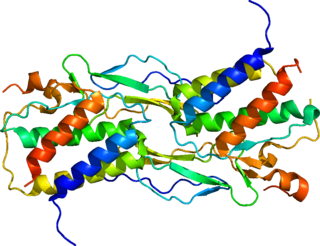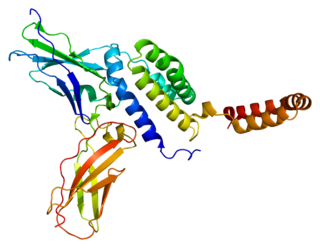
Interleukin-15 (IL-15) is a protein that in humans is encoded by the IL15 gene. IL-15 is an inflammatory cytokine with structural similarity to Interleukin-2 (IL-2). Like IL-2, IL-15 binds to and signals through a complex composed of IL-2/IL-15 receptor beta chain (CD122) and the common gamma chain. IL-15 is secreted by mononuclear phagocytes following infection by virus(es). This cytokine induces the proliferation of natural killer cells, i.e. cells of the innate immune system whose principal role is to kill virally infected cells.

Oncostatin-M specific receptor subunit beta also known as the Oncostatin M receptor (OSMR), is one of the receptor proteins for oncostatin M, that in humans is encoded by the OSMR gene.

Signal transducer and activator of transcription 6 (STAT6) is a transcription factor that belongs to the Signal Transducer and Activator of Transcription (STAT) family of proteins. The proteins of STAT family transmit signals from a receptor complex to the nucleus and activate gene expression. Similarly as other STAT family proteins, STAT6 is also activated by growth factors and cytokines. STAT6 is mainly activated by cytokines interleukin-4 and interleukin-13.

Interleukin-10 receptor subunit alpha is a subunit for the interleukin-10 receptor. IL10RA is its human gene.

Interleukin 1 receptor, type I (IL1R1) also known as CD121a, is an interleukin receptor. IL1R1 also denotes its human gene.

Interleukin-12 receptor, beta 1, or IL-12Rβ1 in short, is a subunit of the interleukin 12 receptor and the interleukin 23 receptor. IL12RB1, is the name of its human gene. IL-12Rβ1 is also known as CD212.

Interleukin 5 receptor, alpha (IL5RA) also known as CD125 is a subunit of the Interleukin-5 receptor. IL5RA also denotes its human gene.

Interleukin-1 receptor accessory protein is a protein that in humans is encoded by the IL1RAP gene.

Interleukin 15 receptor, alpha subunit is a subunit of the interleukin 15 receptor that in humans is encoded by the IL15RA gene.

Interleukin 12 receptor, beta 2 subunit is a subunit of the interleukin 12 receptor. IL12RB2 is its human gene. IL12RB2 orthologs have been identified in all mammals for which complete genome data are available.

Interleukin 13 receptor, alpha 1, also known as IL13RA1 and CD213A1, is a human gene.

Interleukin 9 receptor (IL9R) also known as CD129 is a type I cytokine receptor. IL9R also denotes its human gene.

Interleukin 37 (IL-37), also known as Interleukin-1 family member 7 (IL-1F7), is an anti-inflammatory cytokine important for the downregulation of pro-inflammatory cytokine production as well as the suppression of tumor cell growth.

Interleukin 20 receptor, alpha subunit, is a subunit of the interleukin-20 receptor, the interleukin-26 receptor, and the interleukin-24 receptor. The interleukin 20 receptor, alpha subunit is also referred to as IL20R1 or IL20RA. The IL20RA receptor is involved in both pro-inflammatory and anti-inflammatory responses, signaling through the JAK-STAT pathway.

Interleukin 20 receptor, beta subunit is a subunit of the interleukin-20 receptor and interleukin-22 receptor. It is believed to be involved in both pro-inflammatory and anti-inflammatory responses.

Interleukin 18 receptor accessory protein, also known as IL18RAP and CDw218b, is a human gene.

Interleukin 3 receptor, alpha (IL3RA), also known as CD123, is a human gene.

The interleukin-18 receptor 1 (IL-18R1) is an interleukin receptor of the immunoglobulin superfamily. IL18R1 is its human gene. IL18R1 is also known as CDw218a.

The Interleukin-2 receptor alpha chain is a protein involved in the assembly of the high-affinity Interleukin-2 receptor, consisting of alpha (IL2RA), beta (IL2RB) and the common gamma chain (IL2RG). As the name indicates, this receptor interacts with Interleukin-2, a pleiotropic cytokine which plays an important role in immune homeostasis.

Interleukin-7 receptor subunit alpha (IL7R-α) also known as CD127 is a protein that in humans is encoded by the IL7R gene.




















